Welcome to our series of 100 interviews we will be holding with professional photographers who use mirrorless cameras for work! “Switching to a smaller and lighter system” has become somewhat of a buzz phrase as of late, but many working photographers take this philosophy seriously. From medical reasons such as resolving back and shoulder pain to the simple realisation that bigger does not mean better, photographers are turning to mirrorless systems now more than ever before.
This week’s interview is with Rodolfo and Giuseppe Felici, a father and son team who photograph the daily life of Pope Francis at the Vatican. Members of the Felici family have been official Papal photographers since 1863, and have documented everything from the official visits and kings and governors, to portraits of the Italian royal family and Giuseppe Garibaldi.
Visit Rodolfo and Giuseppe’s photography website
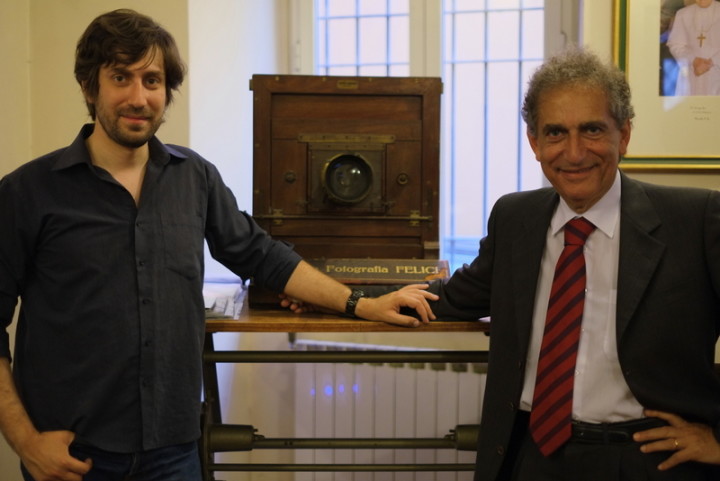
All the images contained in this article are property of Rodolfo and Giuseppe Felici of Fotografia Felici and may not be reproduced in any way.
Who are Rodolfo and Giuseppe Felici in three simple sentences?
Father and son, two photographers, a lawyer and an architect.
This probably isn’t the first time that someone has asked you the following question: what is it like to work in such close proximity to one of the world’s most influential and important personalities?
We feel a great sense of responsibility in our work. Like any other photographer, we are called to document something that is part of history, but in our case the responsibility is bigger. We document a really important moment in the life of all people who meet the Pope. Missing the moment is unacceptable, and we feel deeply sorry when it happens for any reason. The photos we take help the people we photograph to remember the event in the years to come.
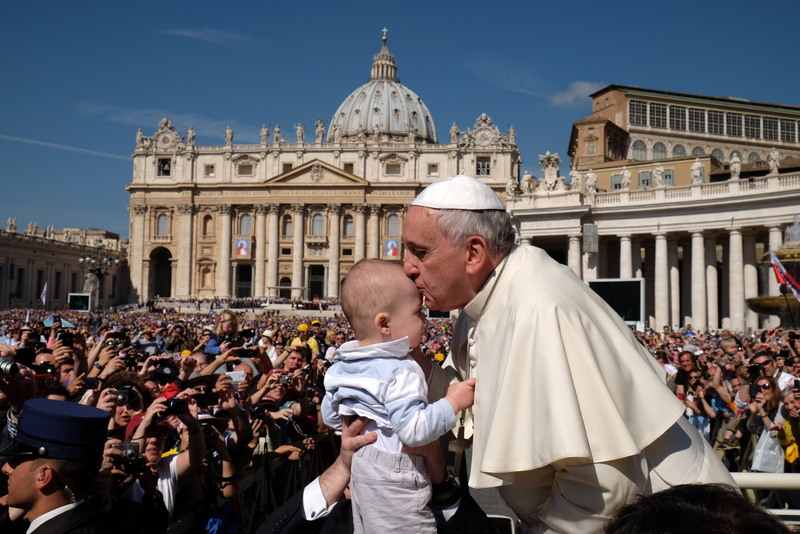
What is your daily work schedule like? Are you called in mainly for specific events or do you also document the daily life of the Vatican?
We document any daily event that happens in Saint Peter’s Basilica (inside or out), in the Paul VI hall (also known as Nervi Hall), in the Sistine Chapel or in the Lourdes Grotto in the Vatican Gardens. They are all places where the Pope holds his public events.
How much freedom does an official photographer have during important events such as the Christmas holy mass? Can you move around easily or are you confined to a specific zone?
We can move around freely but our primary task is to be really discreet, ideally invisible. We know where we can move to be less noticeable, and during celebrations we walk around as little as possible. However, great mobility is often required, like during the Jeep tour in St. Peter’s Square. In this respect, we feel that a small and quiet camera like any camera from the Fuji X series is a great help to accomplish the task.
What would be considered “off-limits” for photographers working at the Vatican?
To take any photo that could tarnish the dignity of the Pope.
How do you think Pope Francis feels about being photographed so often? Would you say that it is something he enjoys?
He loves people, and loves to spend time with them. I think that for the Pope, being photographed is a way to stay in contact with the people even when the encounter is over. I can’t think of anyone who wouldn’t like to have an image to remember the event once back home. It is a way to perpetuate that particular encounter and those emotions in time.
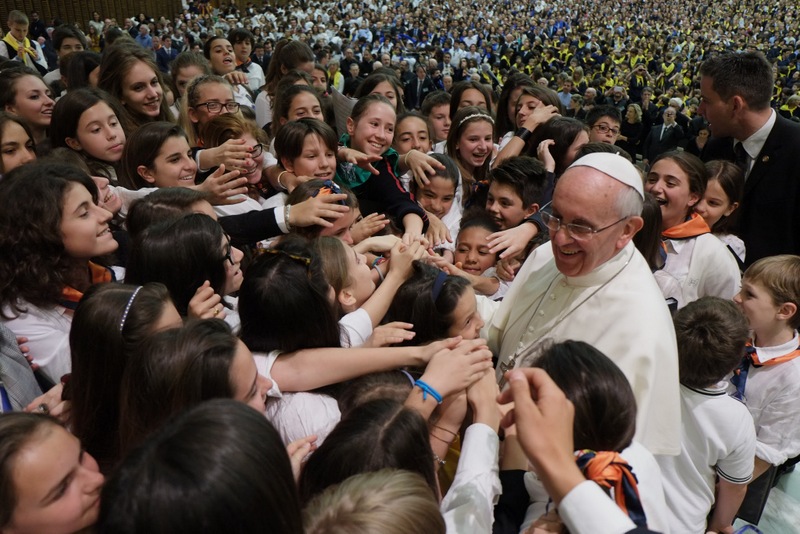
Since 2012 you’ve mainly used Fujifilm X series cameras for your reportage photography. What are the aspects of these cameras that convinced you to switch from the DSLR system?
The lightness, the optical quality and the capability to shoot at very slow speeds without a flash. I love rangefinder cameras for that reasons, and mirrorless cameras are conceptually their successors. Wide angle lenses are much better on a rangefinder. Without a mirror, you can build a lens with the focal plane much closer to the last element, and in this way, for optical reasons you can create a sharper, lighter and brighter lens. Furthermore, without a mirror you can shoot handheld at slower speeds. With the high ISO the sensor can reach today, we have a tool that many photographers never even dreamed of. Quiet, sharp and capable of working at any available light condition.
What is your ideal set-up? How many bodies, lenses and accessories do you use?
It has to be light. The set-up depends on the situation, but usually, I use two cameras, recently an Fujifilm X-T1 with a 18-135 and an X-M1 with a 18mm 2.0 as a back-up body, or an X-T1 with a 55-200 and an X-M1 with a 18-55. The X-M1 is perfect as a back-up body or even as a primary body in any situation where great mobility is required and where a few grams can make the difference in weight. It shares the same sensor and hybrid focusing system of the X-T1, so it is the perfect complement to it. When you do not need it you can simply forget that it’s around your neck, but when you need it you know that you can obtain the same results that you would have with your primary body.
Many people are still reluctant to use mirrorless cameras for work due to important features such as the autofocus being inferior to the performance of a DSLR. With regards to AF, have you found it difficult to use X series cameras for your work? Did you have to adapt to the reactiveness of the Fuji AF system?
I found that the reactivity is at least the same, and probably much better, than the DSLRs of some years ago like the D200 we used to use. I think that the “slow autofocus problem” is mostly a marketing invention. The greatest photographers in history did not have autofocus at all, and Leica M users do not have it even now. Nobody would say that a Leica is not a great tool for taking photos. Maybe we have a slower autofocus than a DSLR? So what? What’s the point? We are simply trading some autofocus performance for a lot of other advantages.
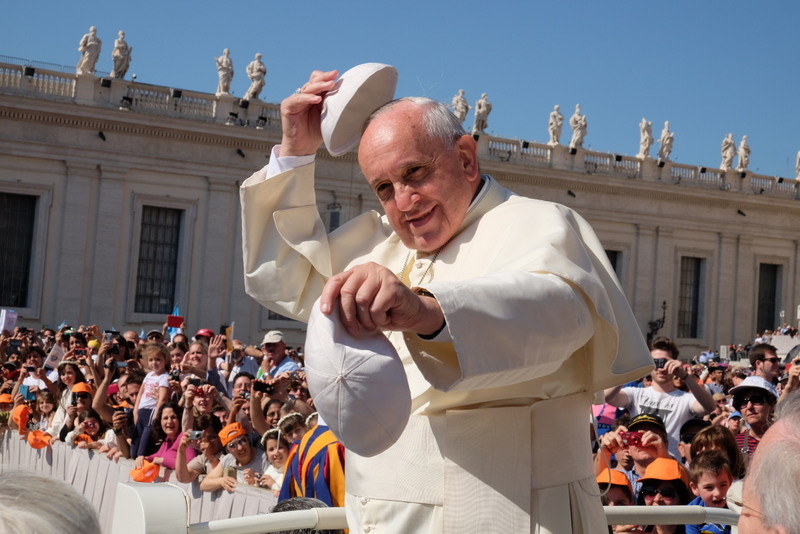
Is there something you miss about your DSLR system? Or if you prefer, is there something you wish that Fujifilm would add to its growing line-up?
No. I just want them to continue the excellent work they are doing now. I would like to see something like a folding medium format digital camera in the future, but I think it is still far off.
If Fujifilm didn’t exist, would you have considered another mirrorless system?
I like the Olympus OM-D series. Probably I would have chosen that camera if they had been closer to the original OM in design (and if Fujifilm didn’t exist).
I saw on your website that the number of photos you take at every event is considerable. Out of curiosity, what is the average number of pictures you take in one day? Do you primarily use OOC JPGs or do you sometimes post-process your best pictures?
It depends on the event. During a general audience in Saint Peter’s Square we can easily shoot about 15,000 pictures in few hours. Obviously we have to work with JPGs, and the ability of Fuji X series to produce the best OOC JPGs around is really important for our kind of work.
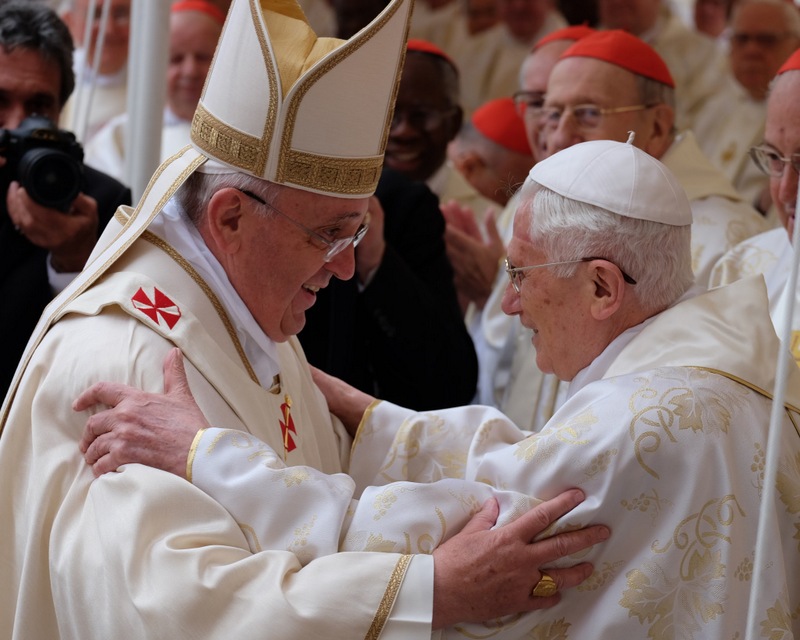
The first pontifical photography shoot was done by your ancestor Giuseppe Felici in 1863. How has your family managed to pass on this profession from one generation to another?
I do not know. It is something we all really care about. It is an important part of our lives, and a very special task, so I think that it is natural that any family would work to keep the tradition alive.
Rodolfo, I imagine that your father has taught you everything there is to know about photography. Do you always work together or do you each have specific responsibilities?
We always work together in Vatican.
I can guess that you’ve accumulated many interesting anecdotes since you both began working as the Pope’s official photographers. Is there one in particular that you’d like to share with our readers?
Some time ago a person during the Jeep tour said to the Pope, “Francis, you are the one and only!”. The Pope, spontaneously, pointing his finger at him, and replied, “You too! We are all one and only!”. Probably only those who were really close to the Jeep at that moment heard these simple words, but I will remember them forever.
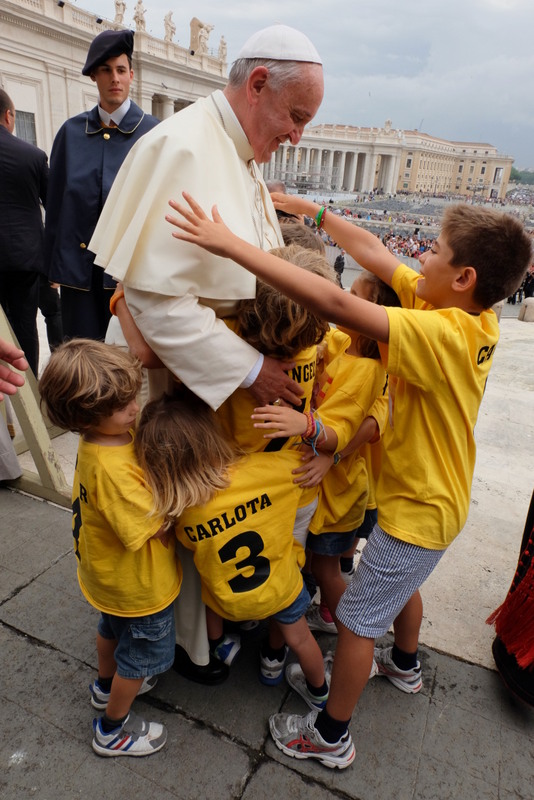
If you have any questions for Rodolfo and Giuseppe about their experience photographing the Pope, be sure to leave a comment below!
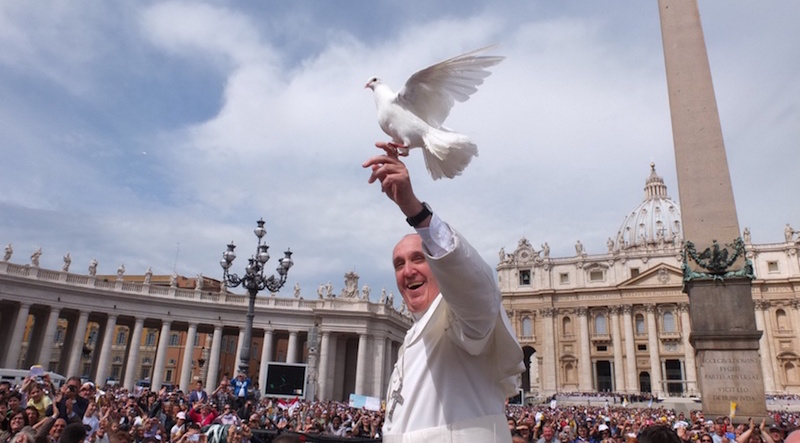
I looked for it online, but I did not find any lab test about the OOC Jpg quality of Fuji.
Neverthless, you can find an influential opinion about the OCC Jpgs of Fuji on this page: http://travel.nationalgeographic.com/travel/top-10-compact-travel-cameras/#/fujifilm-x-e2_74396_600x450.jpg. It is the opinion of Jonathan Irish, program director for National Geographic Adventures.
“I love the X-E1 [precursor to the X-E2]. I love how portable it is, and the lens quality is outstanding. But the picture is the big thing—the images are really strong. I’m amazed at how little I have to correct them on the computer. Usually I shoot in RAW, but these Fujifilm cameras produce amazing JPEGs straight out of the camera.”
Probably he is a Fujifan himself, or sponsored by Fuji, who knows, but National Geographic put the X-T1 and X-E2 at the first two place between the top 10 cameras for travelers.
(I am sorry for the misprints in the previous post, I was writing from my my phone).
@ soundimageplus: I am sorry if I hurt someone with the replies in the interview. I would not to turn this post in a flame, but I will try to answer to your questions.
First of all: sadly we are not sponsored by Fujifilm at all. But yes, I am a Fujifan, and my opinion is probably influenced by this. Anyway we tried any other mirrorless in the trying day organized by the various brands, and I can claim that in my humble opinion the Fuji OOC jpg are simply great. I did not know they was not the best before reading your comment, probably you are right, but onestly they seems to me really good. Various tests online seems to confirm this opinion, but obviously it remains an opinion.
When you answer to an interview, you always express an opinion. For lab tests and data there are other places.
About the battery question: we simply have our pocket full of Patona batteries, at least three, ever. Anyway, the battery life of Fuji cameras outlast by various spans the 300 shots claimed, if you do not use the screen and shot sequentially. You should try.
About the quantity of the shots: I have to confirm that we do that amount of photos in few hours. You can check on our website. The Pope meet a lot of people during a general audience, and it is a difficult task because all happens really quickly. Using a lightweight camera is important for us, more than a faster focus, because in virus situation we have to raise the camera for long periods, and after 45 minutes with the arm raised over the shoulder your muscles begin to hurt. This is the reason because we use also the X-M1, although it is not “professional”.
About the rangefinders: a rangefinder is a mirrorless camera, about any aspect. It is a mirrorless with a range finder for focusing. To build a fast prime wide angle lens on a SLR is more difficult due to the optical schemes you have to use because of the mirror. You can easily obtain fast lens on 50mm focal with a double gauss scheme, but not 28mm or 35mm 2.0.
Please consider that I am only trying to tell our experience replying to the questions received, honestly. All I said is true, from my point of view. Obviously anyone has his own opinion, as in any field of the life.
Best regards,
Rodolfo
I found them almost by chance and thought it could be an interesting story to share. Then of course everyone is entitled to his or her own opinion.
Of course it matters, because it isn’t true. It’s perfectly legitimate to say “We like Fuji jpgs. for what we do. The softness and heavy noise reduction help us to work in mixed light and provide a flattering rendering for the people we photograph.’ But they didn’t. They said ‘and the ability of Fuji X series to produce the best OOC JPGs around’ When in fact the Fuji X series produces some of the WORST jpgs. around, certainly when you take into account sharpness (and lack thereof) dynamic range (poor) and over the top noise reduction.
It also matters because you both, like me, will have readers who are new to all this and are maybe deciding which camera to buy. They see the Pope’s photographers use Fuji X, claim to take 15,000 images in a few hours* and rave about Fuji OOC jpgs. They may well think “That’s the camera for me.’ When in fact it isn’t. And isn’t it the case that we should consider making sure that our readers have ALL the facts and not just some unsubstantiated opinion and what seems to me to be somewhat extravagant and suspicious claims?
*This 15,000 shots is also very odd. Lets say they work for 5 hours flat out. That’s probably more than they could actually do, but lets assume that. There are two of them, so that’s 7,500 each. That’s 1500 shots per hour each, which is 25 shots per minute or one shot almost every two seconds, non-stop for five hours. Now you and I have shot with Fuji cameras, are they capable of that? With relatively slow AF and a not great continuous shooting speed, how is this possible? Now I’m lucky to get 300 shots from my X-T1, so that’s five battery changes per hour, which further slows everything down. Does all this work for you? Because I just can’t see how it’s possible. From my experience of using the 4 Fuji X cameras and 8 Fuji X lenses I currently own, I can’t see how that claim of the number of shots is genuine with the Fuji system. Again one shot every two seconds non-stop for 5 hours?? More if you consider the battery changes. And an X-M1??? I had one of those and I’m not sure it could take a shot and store the image in 2 seconds!! Plus the battery life was worse than the X-T1. And how they can claim that to be a ‘professional’ camera for what is after all a very pressured shooting environment is beyond me.
I love your interviews with mirrorless pro users, obviously being one myself helps, but there is something odd about this one. It just doesn’t seem to ‘sit right’ with me. Obviously you can only publish the answers you were given, but my experiences are telling me there’s something not right here. I’ve shot flat out at weddings and events for hours at a time and I’ve never come close to that number of images and I would have collapsed anyway if I was shooting an image every two seconds without a break!!
Add that to some of the terminology they use.
‘Wide angle lenses are much better on a rangefinder.’??? No they are not. In fact they can cause severe vignetting and colour cast problems. Plus mirrorless cameras are NOTHING like rangefinders in terms of operation.
‘Without a mirror, you can build a lens with the focal plane much closer to the last element, and in this way, for optical reasons you can create a sharper, lighter and brighter lens. Furthermore, without a mirror you can shoot handheld at slower speeds.’???? Again this is simply not true.
‘I think that the “slow autofocus problem” is mostly a marketing invention. The greatest photographers in history did not have autofocus at all, and Leica M users do not have it even now. Nobody would say that a Leica is not a great tool for taking photos. Maybe we have a slower autofocus than a DSLR? So what? What’s the point? We are simply trading some autofocus performance for a lot of other advantages.’ So with this slower autofocus, just exactly how do they achieve their 15,000 shots? And what advantages. Personally I would have thought that something like a Sony A7s would be perfect for what they do.
Plus are they really saying that before using Fuji cameras they were using a Nikon D200? That came out in 2005 and with the workload they claim to have are they really saying that they have been using one (or more) of those for 7 years? Also if that’s their experience of using DSLR’s then how can take what they write seriously?
I’m sorry to bang on about this and as I say, you only published the answers, but I have serious misgivings about some of those answers and I make the point again about how an interview like this can influence what somebody buys. They aren’t sponsored by Fuji by any chance are they?
I don’t think it has anything to do with them being fanboys. If they find the OOC JPGs good enough, then I believe them because their experience is somehow proof. They think that Fuji delivers the best OOC JPG in the world and even if scientific tests will prove the contrary, does it really matter? 🙂
As for the batteries, you are right, that would have been a good question.
Once I read something like that I just switch off. Just because they photograph the Pope doesn’t seem to prevent fanboy misrepresentation. It’s then just yet another example of someone talking up the gear they have bought.
Nothing to do with you, you just asked the questions, but if the replies are yet more brand supporters inaccurate pontification then I’ll stop reading.
One thing did occur to me. If they really do take 15,000 pictures in a session I reckon they need about 50 spare batteries!!!
Come on! 😀
I stopped reading at ‘and the ability of Fuji X series to produce the best OOC JPGs around’